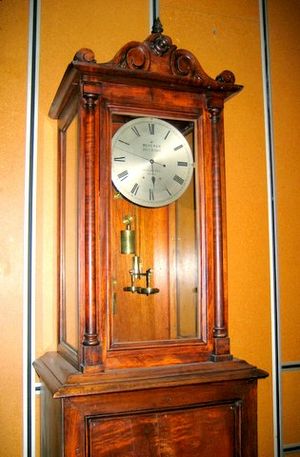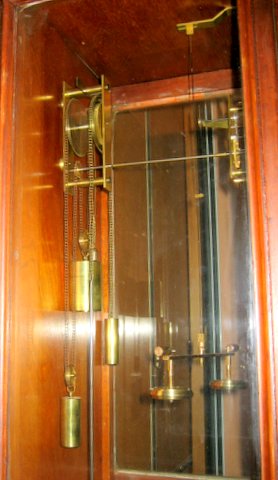Beverly Clock facts for kids
The Beverly Clock is a very special clock located in the Physics Department at the University of Otago in Dunedin, New Zealand. What makes this clock so amazing is that it has been running since 1864 without ever being wound by hand! It was built by a clever person named Arthur Beverly.
Contents
How Does the Beverly Clock Work?
This incredible clock gets its power from tiny changes in the air around it. It uses both changes in atmospheric pressure (how much the air pushes) and daily temperature changes. The temperature changes are actually more important for keeping it going.
Power from Air and Heat
Inside the clock, there's a sealed box filled with air. When the temperature goes up, the air inside the box expands. When the temperature goes down, the air shrinks. These tiny movements of air push on a special part called a diaphragm, which is like a flexible wall.
Even a small temperature change, like 6 degrees Fahrenheit (about 3 degrees Celsius) over a day, creates enough energy to power the clock. This energy is enough to lift a one-pound weight by one inch, which is just what the clock needs to keep ticking!
Similar Clocks
There's another famous clock that works in a similar way, called the Atmos clock. It's made by a Swiss company called Jaeger-LeCoultre. Both the Beverly Clock and the Atmos clock are examples of how clever engineers can use natural energy sources to power machines.
When the Clock Stops (and Starts Again!)
Even though the Beverly Clock hasn't been wound since 1864, it has stopped a few times. This usually happens when its parts need cleaning, or if something breaks inside. It also stopped when the Physics Department moved to a new building.
Sometimes, if the temperature doesn't change enough for a while, the clock might slow down or stop because it doesn't get enough energy. But don't worry! Once the temperature starts changing normally again, the Beverly Clock usually starts ticking right away, all by itself!



